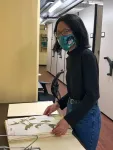(Press-News.org) In earlier days of the COVID-19 pandemic, before diagnostic testing was widely available, it was difficult for public health officials to keep track of the infection's spread, or predict where outbreaks were likely to occur. Attempts to get ahead of the virus are still complicated by the fact that people can be infected and spread the virus even without experiencing any symptoms themselves.
When studies emerged showing that a person testing positive for COVID-19 -- whether or not they were symptomatic -- shed the virus in their stool, "the sewer seemed like the 'happening' place to look for it," said Smruthi Karthikeyan, PhD, an environmental engineer and postdoctoral researcher at University of California San Diego School of Medicine.
From July to November 2020, Karthikeyan and team, led by Rob Knight, PhD, professor and director of the Center for Microbiome Innovation at UC San Diego, sampled sewage water to see if they could detect SARS-CoV-2, the virus that causes COVID-19. They could. But concentrating the wastewater proved to be a bottleneck -- it's a slow and laborious multi-step process.
Now, in a paper published March 2, 2021 in mSystems, the researchers describe how they have automated wastewater concentration with the help of liquid-handling robots. They demonstrated their system's robustness by comparing it to existing methods and showing that they can predict COVID-19 cases in San Diego by a week with excellent accuracy, and three weeks with fair accuracy, just using city sewage.
San Diego County has only one primary wastewater treatment plant, located on the coast in the city's Point Loma neighborhood. All excrement flushed away by San Diego's approximately 2.3 million residents, including those on the UC San Diego campus, ends up there.
Seven days a week, Karthikeyan or a colleague drove down to the treatment plant to pick up wastewater samples that had been collected and stored for them by on-site lab technicians. They brought the samples to Knight's lab on the UC San Diego School of Medicine campus in La Jolla.
"Unfortunately, we can't just directly test wastewater samples the way we would samples from patient nasal swabs," Karthikeyan said. "That's because the samples we get are highly diluted -- just think of the number of people contributing to the waste stream, plus all the junk that gets flushed and makes it to the sewer system."
Back in the lab, the researchers process the sewage using their robotic platform. The system extracts RNA -- the genetic material that makes up the genomes of viruses like SARS-CoV-2 -- from the samples, and runs polymerase chain reaction (PCR) to search for the virus' signature genes. The automated, high-throughput system can process 24 samples every 40 minutes. Later the same day, Karthikeyan adds the data to a digital dashboard that tracks new positive cases.
According to Knight, the technique is faster, cheaper and more sensitive than other approaches to wastewater surveillance. The team is able to identify a single COVID-19 case in a building of approximately 500 people.
Wastewater monitoring key to UC San Diego's Return to Learn program
The researchers and students in Knight's lab are no strangers to dealing with stool samples. The team has long been known for their studies of the gut microbiome -- the unique communities of microbes that live in our gastrointestinal tracts. People all over the world participate in their research program, The Microsetta Initiative (aptly abbreviated "TMI"), by mailing their fecal swabs to Knight's UC San Diego lab. The crowdsourced project has allowed the team to study the many factors that might influence the makeup of a person's gut microbiome, and the many ways it influences our health.
In the spring of 2020, Knight's team quickly pivoted their focus to look for one particular microbe: SARS-CoV-2. Soon the team formed an integral part of UC San Diego's Return to Learn program, an evidence-based approach that has allowed the university to continue to offer on-campus housing and in-person classes and research opportunities. With approximately 10,000 students on campus, the many components of the program have kept COVID-19 case rates much lower than the surrounding community and most college campuses, maintaining a positivity rate of less than 1 percent.
Return to Learn relies on three pillars: risk mitigation, viral detection and intervention. Knight's team and their collaborators play a big role in viral detection on campus. They help screen for the asymptomatic presence of SARS-CoV-2 in students and staff (often self-collected using test kits available from vending machines), on surfaces and in wastewater.
The team continues to collect samples daily from more than 100 wastewater samplers on the UC San Diego campus, which cover more than 300 buildings. Approximately one month after the campus detection system came online in summer 2020, a positive case was detected in the Revelle College area one Friday afternoon. The campus community was notified within 14 hours and targeted messages were sent to people associated with the affected buildings, recommending they be tested for the virus as soon as possible. More than 650 people were tested for COVID-19 that weekend.
As a result, two asymptomatic individuals were identified as being positive for COVID-19. After the campus promptly notified them, they self-isolated before an outbreak could occur. Now, wastewater screening results are available on a public dashboard and positive samples are being sequenced to track the emergence of new SARS-CoV-2 variants. The Return to Learn program, including wastewater testing, has become a model for other universities, K-12 school districts and regions.
"As the barrier to entry and operate continues to drop, we hope wastewater-based epidemiology will become more widely adopted," Knight said. "Rapid, large-scale infectious disease early alert systems could be particularly useful for community surveillance in vulnerable populations and communities with less access to diagnostic testing and fewer opportunities to distance and isolate -- during this pandemic, and the next."
INFORMATION:
Co-authors of the study also include Nancy Ronquillo, Pedro Belda-Ferre, Destiny Alvarado, Tara Javidi and Christopher A. Longhurst, all at UC San Diego.
Funding for this research came, in part, from the UC San Diego Return to Learn Program.
Healthy human bodies are good at regulating: Our temperatures remain around 98.6 degrees Fahrenheit, no matter how hot or cold the temperature around us. The sugar levels in our blood remain fairly constant, even when we down a glass of juice. We keep the right amount of calcium in our bones and out of the rest of our bodies.
We couldn't survive without that regulation, called homeostasis. And when the systems break down, the results can cause illness or, sometimes, death.
In presentations at the American Association for the Advancement of Science's annual meeting, researchers argued that mathematics can help explain and predict those breakdowns, potentially offering new ways of treating the systems to prevent or fix them when things go wrong. The meeting ...
Imagine seeing the world in muted shades -- gray sky, gray grass. Some people with color blindness see everything this way, though most can't see specific colors. Tinted glasses can help, but they can't be used to correct blurry vision. And dyed contact lenses currently in development for the condition are potentially harmful and unstable. Now, in ACS Nano, researchers report infusing contact lenses with gold nanoparticles to create a safer way to see colors.
Some daily activities, such as determining if a banana is ripe, selecting matching clothes or stopping at a red light, can be difficult for those ...
Land stores vast amounts of carbon, but a new study led by Cranfield University's Dr Alice Johnston suggests that how much of this carbon enters the atmosphere as temperatures rise depends on how far that land sits from the equator.
Ecosystems on land are made up of plants, soils, animals, and microbes - all growing, reproducing, dying, and breathing in a common currency; carbon. And how much of that carbon is breathed out (also known as ecosystem respiration) compared to how much is stored (through primary production) has impacts for climate change. ...
Using the model organism Caenorhabditis elegans, researchers at the University of Cologne have developed an 'aging clock' that reads the biological age of an organism directly from its gene expression, the transcriptome. Bioinformatician David Meyer and geneticist Professor Dr Björn Schumacher, director of the Institute for Genome Stability in Aging and Disease at the CECAD Cluster of Excellence in Aging Research and the Center for Molecular Medicine Cologne (CMMC), describe their so-called BiT age (binarized transcriptomic aging clock) in the article 'BiT age: A transcriptome based aging clock near the theoretical limit of accuracy' in Aging Cell.
We are all familiar ...
Alexandria, Va., USA -- The clinical picture of COVID-19 in various target organs has been extensively studied and described, but relatively little is known about the characteristics of oral cavity involvement. The study "Frequent and Persistent Salivary Gland Ectasia and Oral Disease After COVID-19" published in the Journal of Dental Research (JDR), investigated the presence and prevalence of oral manifestations in COVID-19 survivors.
Researchers at the Università Vita Salute San Raffaele, Milan, Italy, profiled the oral involvement in 122 COVID-19 survivors, hospitalized and followed up at a single referral visit after a median 104 days from ...
Systemic fungal infections are much rarer than other illnesses, but they are potentially deadly, with limited options for treatment. In fact, fungi are becoming increasingly resistant to the few drugs that are available, and infections are growing more common. A cover story in Chemical & Engineering News, the weekly newsmagazine of the American Chemical Society, details how scientists are working to improve our antifungal arsenal.
At present, there are only four types of antifungal drugs approved by the U.S. Food and Drug Administration (FDA), and some infections are resistant to those drugs, making surgery ...
Fields are covered with dandelions in spring, a very common plant with yellow gold flowers and toothed leaves. When they wither, the flowers turn into fluffy white seed heads that, like tiny parachutes, are scattered around by the wind. Taraxacum officinale, that is its scientific name, inspired legends and poems and has been used for centuries as a natural remedy for many ailments.
Now, thanks to a study conducted at the University of Trento, dandelions will inspire new engineered materials. The air trapping capacity of dandelion clocks submerged in water has been measured in the lab for the first time. The discovery paves the way for the development of new and advanced ...
CLEMSON, South Carolina - Clemson University scientists have linked climatic fluctuations over the past one and a quarter-century with flower color changes.
Researchers combined descriptions of flower color from museum flower specimens dating back to 1895 with longitudinal- and latitudinal-specific climate data to link changes in temperature and aridity with color change in the human-visible spectrum (white to purple).
The study, which was published in the journal Proceedings of the Royal Society B, showed the change varied across taxa.
"Species ...
PROVIDENCE, R.I. [Brown University] -- Humans have made a remarkable impact on the planet, from clearing forests for agriculture and urbanization to altering the chemistry of the atmosphere with fossil fuels. Now, a new study in the journal Nature reveals for the first time the extent of human impact on the global water cycle.
The study used NASA's Ice, Cloud and Land Elevation Satellite (ICESat-2) to assemble the largest ever dataset of seasonal water levels in more than 227,000 lakes, ponds and reservoirs worldwide. The data reveal that even though human-managed reservoirs comprise only a small percentage of all water bodies, they account for 57% of the total seasonal water storage changes globally.
"We ...
A team from the Chinese Academy of Sciences and Cardiff University say they have found the strongest evidence yet of a "migration gene" in birds.
The team identified a single gene associated with migration in peregrine falcons by tracking them via satellite technology and combining this with genome sequencing.
They say their findings add further evidence to suggest genetics has a strong role to play in the distance of migration routes.
The study, published today in the journal Nature, also looks at the predicted effect of climate change on migration - and how this might interact with evolutionary factors.
The researchers tagged 56 Arctic peregrine falcons and tracked their journeys by satellite, following their annual flight distances and directions in detail.
They found the studied ...



